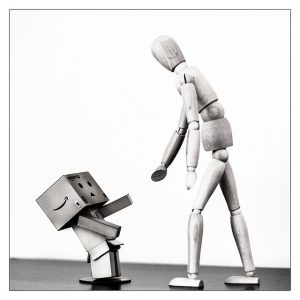Almost every book, which should help you learn Polish, says that „Cześć, jak się masz?” is the Polish equivalent of „Hello, how are you?”. Actually, when you use that phrase, you’re immediately revealing the fact that you’re a foreigner. Saying „Cześć, jak się masz?” is the Polish equivalent of „Hello, I’m a foreigner”.

Do you want to let everyone know that you’re not Polish just at the beginning of the chat? I don’t think so. Usually we learn languages in order to become so good that nobody would ever say you’re not a native speaker. Alright, now I’m going to explain why „Cześć, jak się masz?” is not a good sentence to start with.
The answer is very simple: nobody, who is Polish, would say that. That’s it. How can we greet then? In Polish we have a lot of informal ways to greet people. First, the greeting word („hello”). „Cześć” is a good example. Here are other examples of informal meetings.
Used rather by everyone:
- cześć („hi”);
- hej („hey”);
- witam („I’m greeting”);
- witaj (the imperative form of „greet”. You can say that to one person only);
- witajcie (the imperative form of „greet”. You can say that only to more than one person).
Used rather only by the youth:
- siema (shortened „siemasz” which used to be used years ago. By the way, „siemasz” is shortened „jak się masz?” which used to be used even more years ago);
- siemka (little „siema”);
- siemanko (little „siema”);
- siemaneczko (little „siemanko”);
- hejka (little „hej”);
- yo, joł, jioł;
- elo („hello”);
- eloszka (little „elo”);
All of these are in daily use. If you asked me which of these I use, I’d answer: cześć, hej, hejka, jioł.
Alright, as we have learned, „Cześć” is totally fine. The problem is with the phrase „Jak się masz?”. People used to use this phrase long time ago. Now it’s different.
We have to be aware that the role of „How are you?” in English is just the part of greeting. In Polish such a question is between being the part of greeting and asking about the mood. What I mean by this is: some people will just answer „I’m fine” just to be polite and the other will tell the truth about their mood. I’ll give some examples in a moment. Now, how do we ask „How are you?” in Polish in a regular way (not the strange way like „Jak się masz?”)?
- Co tam? („What there?”).
- Jak tam? („How there?”).
- Co u ciebie? („What at you?”).
- Co tam u ciebie? („What there at you?”).
- Co słychać? („What can we hear?”).
- Co u ciebie słychać? Co słychać u ciebie? („What can we hear at you?”).
- Co dobrego u ciebie? („What good at you?”).
- Jak tam u ciebie? („How there at you?”).
- Jak tam twój nastrój? („How there your mood?”).
- Jak tam twoje samopoczucie? („How there your mood?”).
- Jak tam twój humor? („How there your mood?”).
Some regular answers when you just want to be polite and say „I’m fine” — below.
- Dobrze, dziękuję. („Well, thank you”).
- Wszystko dobrze, dziękuję. („Everything well, thank you”).
- W porządku, dziękuję. („In order, thank you”).
- Wszystko w porządku, dziękuję. („Everything in order, thank you”).
And now some answers when you’re mood is not so good.
- Nieźle, dziękuję. („Not bad, thank you”).
- Tak sobie. („So-so”).
- Jakoś leci. („It passes somehow”).
- Średnio. („Average”).
- Nie najlepiej. („Not the best”).
- Niezbyt dobrze. („Not really well”).
- Nie za dobrze. („Not too well”).
- Słabo. („Weakly”)
- Kiepsko. („Weakly”).
- Źle. („Bad”).
As I have written before, if you want to, you can tell a story instead of saying about your mood. These kinds of stories usually start with the expression „A nic” („Oh, nothing”) or „Nic” („Nothing”). You can also simply start and finish at once by saying „Po staremu” („Just like it has always been”).
Now you can greet Polish people without revealing where you are from! An example of such a dialogue:
— Hej, co tam?
— A nic, właśnie wracam ze sklepu. Musiałem pójść, bo nie było w domu mleka. („Oh, nothing, I’m just coming back from the shop. I had to go because there wasn’t any milk at home”).
Comment the post here or on Facebook.
The image comes from flickr.com.
Dzieki za artykul!
Mnie też „jak się masz?” wydawało się zawsze nienaturalne 😉
When I was writing my scenario for the movie we talked about on FB, I was thinking about one important issue – compaining 🙂 I’ve decided to not add this part, because it might be a bad advertise for me as Polish 🙂 But well, that’s true, that many times if someone asks us „how are you” we would rather say: nothing new, stara bida which means the old poverty (that one is so lame 😀 ), po staremu (something like nothing new) or 100 other 🙂
„Jak się masz” brzmi naprawdę dziwnie, ale jakoś napisała do mnie pewna koleżanka ( i ona jest Polką!) i też pytała „Jak się masz?”…Czemu?! Koniecznie musi przeczytać ten artykuł 🙂
PS. Приветики! 🙂
Margarita, faktycznie doszły mnie słuchy, że w niektórych częściach Polski tego się używa. Pewien chłopak z Wałbrzycha (Dolny Śląsk!) napisał, że „Siemanko, jak się masz?” to typowe przywitanie wśród jego znajomych. Mnie zaskoczyło to bardzo 😉